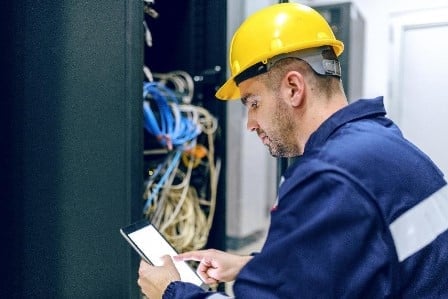Course Overview
This professional development course is designed for engineers and technicians who need a strong understanding of the AS/NZS 3000 standard.
Please note: the AS/NZS 3000 standard is not implemented in New Zealand at this stage.
Course Benefits
- You may be eligible to claim CPD points through your local engineering association.
- Receive a Certificate of Completion from EIT.
- Learn from well-known faculty and industry experts from around the globe.
- Flexibility of attending anytime from anywhere, even when you are working full-time.
- Interact with industry experts during the webinars and get the latest updates/announcements on the subject.
- Experience a global learning with students from various backgrounds and experience which is a great networking opportunity.
- Gain a strong understanding of the Australia – New Zealand Wiring Rules -AS/NZS 3000 standard and its industrial application.
- Learn from experienced personnel on important topics related to planning and design of electrical systems, their installation, or maintenance and the requirements as per AS/NZS 3000:2018.
- Learn how to ensure the safety of personnel against the dangers arising from the use and handling of electrical equipment and appliances.
- Study how to calculate the power demand of a system and the computation of earth fault currents, the procedure for selection and installation of wiring systems.
Course Details
This course covers the requirements laid down in the standard AS/NZS 3000, commonly known as the Australia – New Zealand Wiring Rules. For those installations covered in the scope of this standard, its provisions are mandatory and must be followed. Any engineer involved in the planning and design of electrical systems, their installation, or maintenance, must have a clear idea about the various requirements contained in the standard.
The primary purpose of this standard, like many of its various other equivalent national standards, is to ensure the safety of personnel against the dangers arising from the use and handling of electrical equipment and appliances. The introductory modules of this course outline the basic principles that should be understood for a better appreciation of the standard. These include modules that illustrate the calculation for the power demand of a system and the computation of earth fault currents, as discussed in the appendices of the standard. These are informative and are very important in making an electrical system safe for operation. The actual provisions of the standard are then discussed in detail in the subsequent modules.
Please Note: Students will need to provide their own copy of the AS/NZS 3000:2018 Standards
The course is composed of 12 modules, covering the requirements of the AS/NZS 3000 Wiring Rules and how to apply them, the importance of fulfilling the requirements for safe use of electrical equipment and systems, and simple methods of calculating to check the adequacy of conductors and protective earthing components to ensure safe operation.
Module 1: Introduction and Overview
- Objective of AS/NZS 3000
- Regulation & Legislation
- Responsibilities of Engineers
- Development of the standard
- How to read the standard
- Over-view of the standard
Module 2: Section 1 Fundamental Principals
- Overview of Part 1 of AS/NZS 3000
- Understand definition of terms used in AS/NZS 3000
- Understand the fundamental principles for electrical installations
- Identify the electrical system parameters for Australia (Voltage)
- What to consider when selecting electrical equipment for installation in Australia
- What to consider when installing electrical equipment in Australia
- Understand what is needed to verify an installation
- How to demonstrate compliance to AS/NZS 3000
Module 3: : Section 2 Installation Practices (Part 1)
- Circuit Arrangement
- Maximum Demand calculations
- Types of control in circuits
- Fault Protection: Overload and Short circuit
- Protective Devices
- Coordination of Protective Devices (Discrimination)
Module 4: Section 2 Installation Practices (Part 2)
- Residual Current Devices
- Fault Protection: Under voltage / Over voltage
- Arcing
- Switchboard requirements
Module 5 – Section 3 – Selection and installation of wiring system (Part 1)
- Cable Types
- Wiring Systems
- Cable Selection
- Current Carrying Capacity
- Derating Factors
- Voltage Drop
- Short Circuit Temperature
- Thermal Stability
Module 6 – Section 3 – Selection and installation of wiring system (Part 2)
- Connections
- Identification
- Installation requirements
- Enclosures
- Underground wiring
- Aerial wiring
- Cables catenary
- ESR
Module 7 – Section 4 – Equipment
- Important of selecting correct equipment
- Impact of external factors to equipment selection
- Equipment Connection
- Socket-outlets
- Lighting
- Installation of specific equipment
Module 8 – Section 6 – Damp situations
- IP Rating
- Baths, showers
- Swimming pools
- Water fountains
- Saunas
- Refrigeration
- Sanitisation
Module 9:- Section 5 – Earthing (Part 1)
- Function of Earthing
- MEN Earthing System
- Earth Conductor sizing
- Earth electrodes
Module 10: Section 5 – Earthing (Part 2)
- Earthing arrangement and components
- Continuity and Equipotential Bonding
- Earth Fault Loop Impedance
Module 11 – Section 7 – Special installations
- Safety Services
- Electricity generation systems
- Protection by electrical separation
- Extra-low voltage electrical installations
- High voltage electrical installations
- Installations in areas where an explosive hazard may arise
Module 12 – Section 8 – Testing and verification
- Visual Verification
- Mandatory Tests
- AS 3017
- Periodic Verification
To obtain a certificate of completion for EIT’s Professional Certificate of Competency, students must achieve a 65% attendance rate at the live, online fortnightly webinars. Detailed summaries/notes can be submitted in lieu of attendance. In addition, students must obtain a mark of 60% in the set assignments which could take the form of written assignments and practical assignments. Students must also obtain a mark of 100% in quizzes. If a student does not achieve the required score, they will be given an opportunity to resubmit the assignment to obtain the required score.
Please select the country you live in from the drop-down menu to see the current fees in your region.
Payment Methods
Learn more about payment methods, including payment terms & conditions and additional non-tuition fees.
You are expected to spend approximately 5-8 hours per week learning the course content. This includes attending fortnightly webinars that run for about 90 minutes to facilitate class discussion and allow you to ask questions. This program has a 65% attendance requirement in the live webinars in order to graduate from the program. If you are unable to attend the live webinars, you have the option of watching the recording of completed webinars and sending a summary of what you have learnt from the webinar to the Learning Support officer. The summaries go towards your attendance requirement for the program.
This program is run online on an intensive part-time basis and has been designed to fit around full-time work. It will take three months to complete.
We understand that sometimes work commitments and personal circumstances can get in the way of your studies, so if at any point you feel that you are struggling with the pace of the course or finding a particular module challenging, you are encouraged to contact your designated Learning Support Officer for assistance.
Registrations are open for our upcoming intakes. Please ensure you book your place at least one week before the start date of the program.








